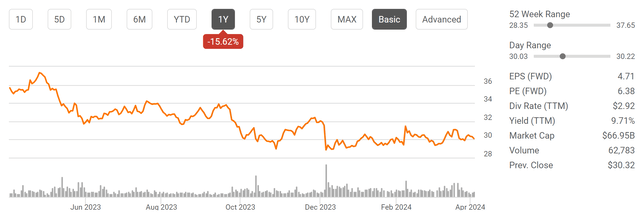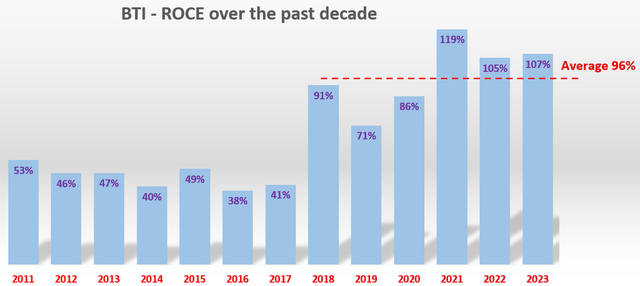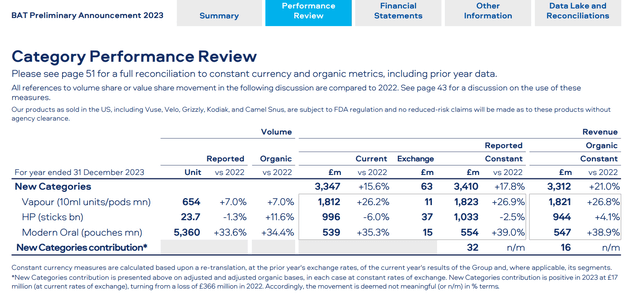~10% yield and ~6x P/E are just absurd
Believe me, I understand why tobacco stocks are so out of favor in recent years. The main topic for today, British American Tobacco (NYSE:BTI), provides a good example. As seen in the chart below, BTI’s price suffered a 15.62% loss in the past year, while the overall market has one of the best rallies. BTI, together with other tobacco stocks, is indeed facing a number of challenges, including decreasing smoking rates, shifting consumer preferences, regulatory pressures, etc.

Seeking Alpha
As such, I’m not here to deny these challenges. I’m here to argue that the fear of these challenges is overblown and thus presents a contrarian investment opportunity. The fear is so overwhelming that BTI now yields close to 10% (9.7% to be exact) and trades at 6.4x FWD P/E, as you can see from the chart above. Such a combination is simply absurd except under one of the two scenarios:
- The dividend payouts are unsafe and a cut is imminent.
- The underlying business is chronically unprofitable and likely to stagnate permanently.
In the remainder of this article, I will argue that neither of these scenarios is likely in the case of BTI.
Dividend safety
Let’s look at the possibility of a dividend cut first.
I will start with a simple reality check and look at its payout ratios. The chart below shows its cash dividend payout ratio for the last four years. We can see that the payout ratio is 49.99% currently and the average in this period is 52.77%. A ~52% average is conservative to start with (i.e., BTI pays out only about half of its cash flow in dividends). The current payout ratio is further below the average. In fact, after paying its dividends, the company still has plenty of cash to engage in share buybacks and debt reductions as seen in the second chart below.

Seeking Alpha

BTI investor presentation
Now speaking of debt reduction, the strength of a business’ balance sheet is an important factor for its dividend safety. Unfortunately, it’s a factor that’s not captured in the simple payout ratios. We have been reminding dividend investors whenever we can to dig beyond those simple payout ratios.
For BTI, the news is all good the way I see it. As seen in the chart below, its debt ratings are consistently in the upper medium end of the investment grade range with either a stable or positive outlook. To wit, Fitch’s rating is F2 (Short-term) with a stable Long-term outlook, Moody’s rating is P-2 (Short-term) Baa2 with a positive long-term outlook, and Standard & Poor’s rating is A-2 (Short-term) with a stable long-term outlook. Hence, I see no concern here. On the opposite, I expect its balance to further strengthen going forward as management uses the extra cash to pay down debt. For example, in 2023, the leverage was reduced to 2.6x only.

BTI debt ratings
Growth potential
Now let’s check the profitability and growth issues. In my mind, a ~6x P/E is only reserved for businesses that are chronically unprofitable and/or likely to stagnate permanently.
BTI is the polar opposite of being unchronicled and unprofitable, in my view. It has been enjoying astronomical profit margins as you can see from the first chart below. It has a profitability grade of A+ across all the main metrics. For example, its gross profit margin is around 82.07%, which is significantly higher than the sector median of 34.28% by more than two-fold. Its EBIT margin and EBITDA margin exceed the sector median by even larger gaps. My own analysis of its return on capital employed (“ROCE”), shown in the second chart below, confirms the magnitude and consistency of profitability. As seen, it has been maintaining an average ROCE of around 96%, on par with some of the best technology companies such as Apple (AAPL).

Seeking Alpha

Author using Seeking Alpha data
In terms of growth, it’s true that global tobacco industry volumes will likely continue to trend down in the coming years. However, I’m confident in the strength of its New Category products led by Vuse and Velo. The former product now has a 37% market share in key markets, while the latter has a 46% share in the U.S. Sales of these goods have been growing at a robust pace. As seen in the first chart below, its Vapour, heated products and modern oral products reported 7%, 11.6%, and 34.4% YOY organic volume growth in 2023. In terms of market share, the new category also is expanding into new markets at a neck-breaking pace (as seen in the second chart below). As of December 2023, these products have entered a total of 24 markets, compared to only three years ago. Finally, 2023 might be the pivot year for its new products as this group is anticipated to post an operating profit for the first time as seen in the second chart below. BTI plans to continue to invest in smokeless products so that by 2035 50% of total sales will come from non-combustible products. Currently, only about 10% of the world’s roughly one billion smokers use New Category products, so I see a very good long-term opportunity on this front and share management’s optimism.

BIT 2023 Q4 earnings report

BTI investor presentation
Wall Street analysts seem to share the optimism too. The next chart below shows analysts’ consensus estimates for BTI’s future earnings growth in the next three years. As seen, for December 2025, they project an EPS of $4.99, representing a growth of 5.83% YoY. And for December 2026, the projected EPS is $5.23, reflecting a growth of 4.76% YoY.
An annual growth rate of ~5% is nothing to sneer at for a mature business like BTI. Especially when it’s trading at ~6x P/E only, I see any growth as a huge plus. At this pace of growth, its forward P/E ratio would shrink to only 5.76x in 2~3 years. Such a lower P/E ratio, combined with superb profitability and a healthy rate of growth, suggests good outs for a large valuation expansion in my mind.

Seeking Alpha
Risks and final thoughts
To recap, it’s undeniable that the tobacco industry is facing strong headwinds and BTI is no exception. The smoking rates are likely to keep the decreasing trend. The industry also has to accommodate shifting consumer preferences and navigate regulatory pressures. Besides these common risks, there also are some risks that are more particular to BTI in my view compared to other tobacco companies. First, BTI relies more on emerging markets. It has a larger presence in some emerging markets compared to other peers such as Altria. These markets can be more volatile and unpredictable, with greater economic and political risks. Also, as a global player, its earnings can be impacted by fluctuations in foreign exchange rates.
All told, I think the positives far outweigh the negatives. As such, I see a compelling opportunity for contrarian investors. Its current combination of absurdly high yield and low P/E suggests: A) a dividend cut is imminent, and/or B) it’s chronically unprofitable and will stagnate permanently. But as argued above, I see the exact opposite scenario given its strong cash flow, financial strength, profitability, and growth potential especially in the new category.
Read the full article here



